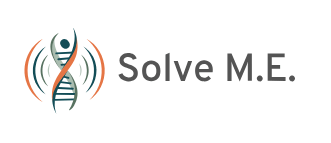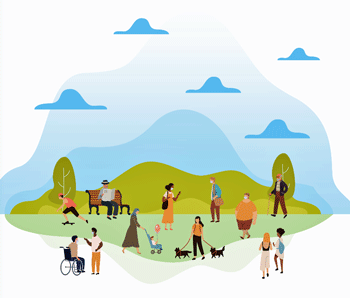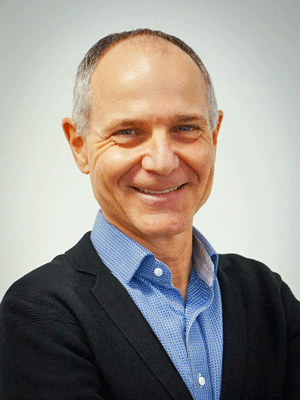


Solve ME has many irons in the fire.
Earlier this year I talked with Solve ME’s Chief Executive Officer Oved Amitay and Vice President of Advocacy and Engagement Emily Taylor. I wanted to know what was going on with the oldest U.S. ME organization. Since its founding in 1987, Solve ME (originally the Chronic Fatigue Immune Dysfunction Syndrome (CFIDS) Association of America) has basically been through it all.
Nothing, though, has compared with the emergence of millions of people having an ME/CFS look-alike – long COVID. The emergence of long COVID has pulled Solve M.E. in new directions. It was instrumental, for instance, in setting up the Long COVID Alliance -which has over 100 partners – whose mission is to educate policymakers and accelerate research efforts and find treatments. Solve M.E.’s last major advocacy efforts have focused on long COVID legislation and for now it’s all about leveraging the interest in long COVID to make strides for it and ME/CFS.
Solve M.E. is not alone. Health Rising – a website that started out being solely focused on ME/CFS – has done more blogs on long COVID recently than any other subject. It’s where the action is. I asked what did they think will happen with long COVID? Will it merge into ME/CFS? Stay a separate disease? Become something else entirely?
New Field – New Need
Their answer was interesting and somewhat typical. Instead of asking what will become of this or that disease they expanded the question and asked what to do with the emergence of this new field – the field of post-infectious disease research or to be more accurate “infection-associated chronic illnesses”.
The question is how to build a new field – a field dedicated to post-infectious disease research. Post-infectious disease research has no dedicated funding, no organized approach, no well-defined research networks, and doesn’t even have a home at the National Institutes of Health (NIH). In short, except for the interest in it, it doesn’t have any of the organizational elements that help medical fields thrive.
While ME/CFS doesn’t have a home at the NIH we should note that neither does, despite its large amount of Congressional funding, long COVID! Other diseases that are often triggered by infections get miserable funding. Postural orthostatic tachycardia syndrome (POTS), for instance, is more poorly funded than ME/CFS. Post-treatment Lyme Disease Syndrome (PTLDS) looks just like ME/CFS symptomatically yet the two are hardly ever studied together.
Oved noted that science is guided by structure and is that ever apparent with ME/CFS. ME/CFS’s funding at the NIH is dependent on the whims of a group of Institutes at the NIH – none of which have responsibility for it. Its precarious perch was revealed, once again, last year, when it came time to re-up funding for its three small research centers. Several Institutes that formerly supported the research centers stopped funding them entirely, leaving it up to two Institutes (NINDS and NAIAD) to fill the gap – which they did – but no more.
Emily noted, though, that one thing long COVID has done is bring diseases together that hadn’t collaborated with each other before. (Witness the Care for Long COVID Act that our 2023 Advocacy week was devoted which was supported by over 60 organizations. )
Bold Initiative
“Concerning all acts of initiative (and creation), there is one elementary truth, the ignorance of which kills countless ideas and splendid plans: that the moment one definitely commits oneself, then Providence moves too. All sorts of things occur to help one that would never otherwise have occurred. A whole stream of events issues from the decision, raising in one’s favor all manner of unforeseen incidents and meetings and material assistance, which no man could have dreamed would have come his way. Whatever you can do, or dream you can do, begin it. Boldness has genius, power, and magic in it. Begin it now.”― W.H. Murray

The key to making really rapid progress in infection-associated chronic illnesses (post-infectious diseases) is creating a home for them at the NIH.
The big answer for post-infectious diseases is a bold one – create a new home at the biggest medical research funder (the NIH) for them. Talk about bold. Solve’s initiative to create a new post-infectious disease or infection-related chronic disease Institute at the NIH is big, exciting, fraught with peril, and totally enrolling.
It’s a bold initiative but as Murray points out bold initiatives like this raise “in one’s favor all manner of unforeseen incidents and meetings and material assistance, which no man could have dreamed would have come his way.” We are not alone. No one is happy with the NIH’s effort on long COVID and fibromyalgia, chronic Lyme disease, and POTS affects tens of millions of people who are getting crappy care. Plus the coronavirus is putting a spotlight on the role infections play in autoimmune and other diseases. Now is the perfect time to start this off.
Is something like this in the air? Perhaps. Recently we saw the emergence of Metrodora, a research and clinical center devoted entirely to these diseases whose raison d’être was the need to study and treat these complex diseases together in one place.
It will take time but it can be done and steps along the way will enhance and further all these illnesses. The last Institute created – the National Institute on Minority Health and Health Disparities (NIMHD) – was birthed in 2010. First, it became an Office in 1990, then a Center in 2000, and by 2010 had morphed into a full-blown Institute.
The NIH, Emily said, needs new structures that reflect the new era of disease we’re in. That means creating an NIH Post-Infectious Disease Institute that focuses on chronic, difficult-to-diagnose diseases such as ME/CFS, Long Covid, fibromyalgia, multiple sclerosis, chronic Lyme disease, and POTS, among others.
Oved noted that the one Institute virtually everyone has heard of – the National Cancer Institute – was not created by the NIH – it was created by Congress. The National Cancer Act of 1937 that created the NCI was groundbreaking – it was the first time Congress ever allocated funds for a noncommunicable disease. Next, a 1944 Congressional bill made the Institute an operating division of the National Institutes of Health (NIH). Then in 1971, the National Cancer Act of 1971 established 15 new cancer research centers and an international cancer research data bank and further structurally firmed up the field.
At each step, Congress stepped in and that’s a good thing as we have far more sway with Congress than we do with the NIH. The way the NIH is structured doesn’t give it much freedom to push a lot of funding toward one disease or the other. It needs Congress to do that.
Creating a new Institute at the NIH is a long-term project that would begin with the creation of an “Office for Infection-Associated Chronic Illness Research” (IACIR) in the Office of Research on Women’s Health (ORWH). The ORWH is the Office that basically saved ME/CFS from disappearing from the NIH for decades.
Enrolling the Private Sector
The feds aren’t everything – not at all. The private sector plays a vitally important in medical research and treatment. It’s particularly for ME/CFS for the simple reason that it’s been almost totally missing. Other diseases get a lot of private sector interest but not ME/CFS.
Oved’s background is in the pharmaceutical industry, and he’s made one of Solve ME’s major goals getting private industry engaged with ME/CFS. Solve’s partnership with the Biotechnology Innovation Organization (BIO), which advocates for diseases in both the public and private arena, for instance, is designed to get private industry to view ME/CFS as a disease it can work with. Molecular pathways that private industry could tweak in ME/CFS have already been identified, Oved said. What’s needed now is to enroll private industry in taking on ME/CFS.
I asked how interest in long COVID and ME/CFS is now – is it expanding or declining or staying the same? Oved noted how things had changed. Just a few years ago there was zero interest in ME/CFS in the media. Back in 2020 Oved had trouble getting an op-ed by Komaroff on ME/CFS and long COVID published – now they can’t keep up with the number of media mentions. One study found more mentions of ME/CFS in a week now than in entire years past and the reporting is mostly accurate. That’s a big shift from the bad old days when a psychologizing tone often crept into media stories on ME/CFS.
Getting ME/CFS Into New Rooms

Solve ME’s long COVID white paper was the first to illuminate the economic costs of long COVID. It got ME/CFS and long COVID into new rooms.
To keep policymakers and funders engaged we need to get their attention. Solve ME’s 2022 30+ page white paper “Long Covid Impact on Adult Americans: Early Indicators Estimating Prevalence and Cost” produced in February, last year, did that in spades. The White Paper was the first paper that I saw that used models to point out the potential economic costs of long COVID. It was an eye-opener. I asked Emily what its impact has been.
Emily reported that the impact of the paper on Solve ME itself turned out to be dramatic. For one, it helped ME/CFS get into “another room” – one of Emily’s key goals. The paper helped Solve ME to enter into a year-long partnership with Global Interdependence Center (GIC) and touch an audience and a field – economics -that hadn’t been exposed to either ME/CFS or long COVID before. Emily ended up leading several events regarding the paper’s findings and talked about the repercussions of long COVID at some major economic summits. Her new audiences, she said, were a blank slate – they had never heard of ME/CFS or post-viral illnesses before.
The paper was produced with an eye towards Congress, and it resonated with Congressmen and women who, until the production of that paper, had no idea of the potential rather dire economic implications of long COVID. Over time the Brooking Institute, Harvard including U.S. Secretary of the Treasury, Larry Summers followed up with additional analysis.

ME/CFS is now a priority illness in a major funding program.
ME/CFS Becomes a “High Priority”
“Before we were just one of many, now we are first among many” Emily Taylor on the high priority given to ME/CFS grants now.
The NIH, of course, remains a sore spot. Despite the emergence of long COVID, it has not provided ME/CFS any more funding. Emily noted that the NIH’s hands are to some extent tied. It can move forward on a disease only slowly. Basically, it’s difficult to reappropriate money from one disease to another. The recent budget increase Congress gave the NIH, for instance, was all accounted for before it hit the NIH’s coffers and it didn’t include ME/CFS. Once again, the way out, Emily noted is Congress. That’s where you can make big changes quickly.
THE GIST
- Take about bold! Solve’s initiative to create a new post-infectious disease or infection-related chronic disease Institute at the NIH is big, exciting, fraught with peril, and totally enrolling. It would be a game-changer for diseases like ME/CFS, Long Covid, fibromyalgia, multiple sclerosis, chronic Lyme disease, and POTS, among others.
- Science is guided by structure and without these diseases having a home in which they can be studied thoroughly, the research will always be scattered, inefficient, and insufficient.
- The first step in what will be a long effort is to create a Center for them first. Congratulations to Solve for the vision to take this bold step. With tens of millions of people with these diseases getting woefully poor treatment, my guess is that we’re going to get support for this initiative from quarters we don’t even know yet.
- On the private funding side Solve’s partnership with the Biotechnology Innovation Organization (BIO), which advocates for diseases in both the public and private arena, for instance, is designed to get private industry to view ME/CFS as a disease it can work with.
- Solve’s white paper on the economic costs of long COVID gave it – and ME/CFS and long COVID – entree into economic circles and policy discussions – which neither ME/CFS nor long COVID had engaged before.
- Neither of the bills we lobbied for passed but a provision from the Care for Long COVID was folded in the appropriations bill and funded. It gave $10,000,000 to the Agency for Healthcare Research and Quality (AHRQ) to assess whether people with post-infectious illnesses such as long COVID and ME/CFS are getting access to quality healthcare.
- For the first time, ME/CFS was declared a high-priority disease in the $370 million Congressionally Directed Medical Research Program (CDMRP) grant funding program at the Dept of Defense. Emily said, “Before we were just one of many, now we are first among many“.
- A big donation to Solve went to a bevy of treatment pilot studies plus a dramatic expansion in the You+ME (soon Solve Together) Patient Registry.
- Finally Oved Amitay – only Solve’s 3rd leader in the last forty or so years, is stepping after 3 years on the job. I really appreciated Oved’s efforts at broadening Solve’s reach. A search for his successor is underway.
We were pushing two pieces of legislation last year – the Care for Long COVID Act and the Treat Long COVID Act. Neither passed but one of the provisions in the Care for Long COVID was folded in the appropriations bill and funded. Ten million dollars was given to the Agency for Healthcare Research and Quality (AHRQ) to assess whether people with post-infectious illnesses such as long COVID and ME/CFS are getting access to quality healthcare.
Another win came with the Congressionally Directed Medical Research Program (CDMRP) at the Dept of Defense. A couple of years ago Solve ME got ME/CFS research embedded into that $370 million pool. No ME/CFS grants were funded out of the CDMRP last year but in past years several million dollars of ME/CFS grants were funded. This year, though, we’re getting special treatment – ME/CFS and long COVID were singled out as high-priority items for the CDMRP. Emily said, “Before we were just one of many, now we are first among many“.
The CDC’s ME/CFS program was also renewed. (It’s a line item in the budget which means it has to be renewed each year to go forward. The CDC leadership apparently uses “us” as a bargaining tool. Knowing we’re going to get put back in at the last minute, they cut us out of their requested budget .) This year we asked for an increase in the program. That didn’t work out but Emily was told that it got further up the line than ever before; i.e. we’re getting closer to a major budget increase there.
The Big Donation
I asked what impact the $3 million dollar grant Solve ME got a couple of years ago. Oved said the person, who shall remain anonymous, has a family member with ME/CFS. Solve ME used part of it to double down on the Ramsay program – with a special emphasis on treatment in hopes of finding something that can help people now. The Ramsay program provides small grants that help researchers get the data they need to apply for really big grants.
Treatment Focus Pt. I
Recent trials have focused on a wide range of possibilities including fecal transplantation, stellate ganglion blockades, enhanced external counterpulsation, and inspiratory muscle training. Plus Solve ME facilitated a repetitive transcranial magnetic stimulation study.
From Jarred Younger to Bhupesh Prusty, Liisa Selin, Michael VanElzakker, and Carmen Scheibenbogen the Ramsay’s have helped many ME/CFS researchers move forward.
Treatment Focus Pt. 2
Solve also used the donation to reinvent the You + ME Patient Registry (now called Solve Together to make it a more effective research tool that can be used in clinical trials. To that end, they’re currently exploring how patient registries have been used in cancer and multiple sclerosis to further treatment trials. Look forward to being able to hook your electronic and wearable data into the Registry soon. Oved called them incredibly powerful tools to understand who responds and who doesn’t respond to different treatments.
On the treatment front, Oved reported that RECOVER is going to announce four more trial platforms soon.
All of US (including ME/CFS)

Solve ME has begun a study analyzing the genetic data of ME/CFS patients in the All of US research program.
Oved said his aim at Solve ME was to have the organization be a catalyst. We can see that in its efforts to bring in private industry, to create partnerships with BIO and the Global Interdependence Center, to help found the Long COVID Alliance, to create a foundational infrastructure in the Patient Registry, and to produce the Ramsay Awards.
Another catalytic venture involves the NIH’s All of US program which is gathering genetic data on a large scale in the US. All of US recently started to publish and make available some of their data. The program gives US-based non-profits the opportunity to become authorized researchers and make use of the data for free. Solve ME applied for and became an authorized researcher and discovered thousands of ME/CFS patients in the ALL of US data. They’re now partnering with the SCRIPPS institute to analyze that data.
Looking for a New Leader

After 3 years at the helm of Solve ME Oved Amitay is stepping down.
Three weeks ago, Oved Amitay reported that after three years at the helm of Solve ME he was stepping down. He stated: ‘
“I have renewed excitement to leverage my experience to help advance diagnostics and therapeutics — areas where I can best use my skill set and connections, serving the community and Solve in a different role. I will also dedicate more time to emerging needs within my family.”
For me, I applauded Oved’s focus on making Solve ME a catalyst, to have it embrace long COVID, and increase outreach to other disease organizations. During his time Solve ME received the largest donation in its history and it’s moving forward with plans to expand the Patient Registry. I’m sorry that he’s leaving.
The Solve ME Board has a new job to do – finding a leader for oldest ME/CFS organization going. They have a good track record. First, there was Kim McCleary who kept Solve (then the CFIDS Association of America) going for 22 years (!) as most other ME/CFS organizations died on the vine. Then came Carol Head who as a person who’d had ME/CFS, brought her own blend of fight and pragmatism to the table. Health issues forced her to retire after almost six years at the helm. (She’s still a Board Member). Most recently, of course, there was Oved Armitay who spent just over 3 years at the helm.


 Health Rising’s Quickie Summer Donation Drive is On!
Health Rising’s Quickie Summer Donation Drive is On!



Hi Cort,
what happens with the ME/cfs patients that had not an infectious onset? they have no way to go or what?
thanks!
If ME/CFS is considered a post-infectious disease I don’t see that it matters. For one, we now know that people can come down with long COVID without ever realizing they had been infected. Given that how does anyone know if their illness was not triggered by an infection?
Many people can identify an infectious trigger plus an infection induced disease makes so much sense in ME/CFS – it looks, after all, like the “sickness behavior” symptoms produced during an infection.
You cut everyone without a clear infectious onset out of this group – but what good would that do? They look exactly like the infectious onset. Until proven differently they are the same.
You have to start somewhere – and this is a great context for the field to cohere around, and get more resources. IF you get more resources then you have the opportunity to study the non-post infectious patients if necessary. First, though, you have to get the resources.
The classic example of CFS is a patient that got Epstein-Barr virus during childhood (maybe even asymptomatic) and then later in life, tirggered by stressful situation, comes down with CFS/ME. So yes, you can still have an infectious onset, even when you don’t know it.
I bought the lifetime access to the Living From Inspiration online summit and I have been going through the presentations. One of them was Dr. Jacob Teitelbaum, MD. So I bought his book.
He claims to cure people of ME/CFS and Fibro using massive amounts of antibiotics, anti-virals and anti-fungals for long periods of time. This suggests that they are post-infection diseases.
I have often said I will try anything, but for me, this would be a bridge too far. I am not willing to take huge doses of these chemicals for years. I don’t think there has been research enough to show that it would be safe, for one.
One other presenter, however, gave evidence for Methylene Blue. I did not know, for example, that methylene blue was the first antibiotic approved by the FDA way back in the 1800’s. It was used for malaria until quinine and chloroquinine were developed. Now that the malaria parasite is developing resistance to those drugs, they are returning to methylene blue for malaria.
So I got some. I must say that I felt better even at the first dose. Now, having been on it for a couple of weeks, I feel like this improvement will stick around. We’ll see, of course. No side effects except that it turns your urine green (yellow + blue = green). Has anyone else tried this?
Anni1, do you take methylene blue as a tincture or as powder and at what dosage? there isn’t much information about it.
Hi JK
Tincture means “dissolved in alcohol” and I can’t take any kind of alcohol because I am histamine intolerant. Tablets turn your mouth and teeth blue, but supposedly it only lasts for half an hour. There are lozenges and troches:
troscriptions.com
that also turn your mouth and teeth blue. The most important point is that you buy “USP grade” and not “Lab grade” and especially not the kind used for aquariums (it’s for killing bacteria in the water of the aquarium).
Here’s where I buy mine:
https://cztl.bz/
but you can also buy the CZTL brand on Amazon. I can even buy it on amazon.ca here in Canada.
There is a good video on Youtube about how to dose this:
https://www.youtube.com/watch?v=dYlTsQNP5iM
and in one of the comments someone suggested putting the mixed 1% solution (1 gram of powder in 100ml of sterile water) into a capsule. So that’s what I do. Start slowly with one or two drops in an emply capsule and work your way up to 1-2cc. One cc fits into an empty gelatin “000” capsule. Swallow it immediately before the gelatin starts to break down! No blue teeth, and no stomach ache (something I have great difficulty with when using any kind of supplement).
More information about methylene blue including history and use:
https://nootropicsexpert.com/methylene-blue/
from this website: “Methylene Blue functions as an alternative electron carrier in the electron transport chain in mitochondria. It accepts electrons from NADH and transfers them to cytochrome c.”
It crosses the blood/brain barrier to improve the oxygen transport from blood to cells. I noticed clearer thinking after my first dose of 3 drops.
When you buy it from CZTL you get one gram in a little vial. If you buy five, you get five little vials. The powder is not blue, it is a bronze colour but when you mix it into sterile water it turns deep dark cobalt blue. You must be very careful not to get it on your hands or your countertop because it stains very badly. It’s not hard, you just have to be careful. I mix it in a dropper bottle and use the dropper to put 20 drops in a 000 capsule. Maybe do it outside? The video says outside is best, but I do it in the kitchen.
Some people say you can add vitamin C powder to the mixture and it will turn from blue back to clear. I have not done this because I can’t take vitamin C, but I’ve read about it.
Good luck and if you have any questions, just ask.
Thanks Cort, appears at least hopeful. Was really glad to see NIH’s All of US program is gathering genetic data. As varied as all our symptoms are and the variety of things that help different people, I really think that collecting genetic data is the key to figuring out what treatments will help what particular group. AI should be a huge help with processing a lot of data quickly but we need experts in the ME/CFS field to analyze the data and make sure the AI is on track. It’s going to be a big job separating all the component parts of these complex diseases!
Unfortunately, this is too much money. Seems like less than 20 mil, a lot of work gets done. 100’s of millions, it will get siphoned off into some drug company for R&D… and it’s gone.
Thanks for this superb summary Cort..The momentum of numbers is gathering speed and after all these years of darkness it is making me want to cry .tears of happiness
I wanted to draw attention to an impact that SOLVE M.E. is having on another part of the world and how encouraged I personally feel that people with amazing research knowledge are trying to help those of us suffering from ME/CFS.
I believe it was last year that SOLVE M.E. awarded a Ramsay grant to Katherine Seton, a young researcher based at the Quadrum Institute in the UK, if memory serves me correctly I have read that she has suffered from ME herself. She is part of Simon Carding’s research team at the Quadrum.
Simon Carding recently gave an encouraging update on the work of the team at the IIMER conference held in the UK. Invest In ME Research have posted the video of his presentation along with many others on their website, here is a link to his presentation
https://youtu.be/d6Y19w4OQVI
In his presention his also mentions that the Come Back Study is almost finished and that results may be available soon (hope I have put this correctly) for those who are interested and that the FMT study at the Quadrum is due to start soon. Many of you will have already watched the presentations but just in case you are unaware thought I would draw attention to them, as mentioned earlier I felt personally encouraged by the work he mentions and feel hopeful it will shed more light on the questions we all have.
Below is another link regarding the Carding teams work from a round up by the ME association, it is paper 7 “Comprehensive profiling of the human Intestional DNA virome and prediction of disease….” I believe it is a pre-print. Hope the link works.
https://meassociation.org.uk/2023/07/me-cfs-research-published-26-june-3-july-2023/
Ive occasionally done questions on a few me/cfs groups re onset cause. A great many including myself had no clear onset and many onset were post trauma. They need to move past finding pathogens as only cause.